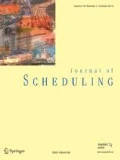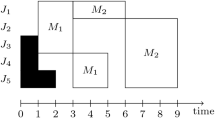Abstract
This paper addresses the minimization of sequence-dependent setup costs in feeding batch processes. Since feeding batch processes often supply subsequent time-critical stages with modules, hard due date restrictions have to be met. It is common that feeding batch processes possess a specific structure of setup costs that are proportional to resulting machine state differences. If each job has a different batch type, the integration of hard due dates leads to a problem that is equivalent to a specific variant of the Line-TSPTW with general processing times and deadlines. We show that this well-known problem, whose complexity status has been unknown for a long time, is binary \(\mathcal{NP }\)-hard. Although the more relevant version with a constant number of batch types is known to be strongly polynomial, no practically applicable exact solution method can be found in the literature. Therefore, this paper proposes new solution algorithms. Specifically, Dynamic Programming and Branch&Bound approaches are developed. By making use of a modified problem definition, a new enumeration scheme, and a specifically designed dominance rule, even complex problem instances with up to 200 jobs are optimally solved by a new best-first Branch&Bound algorithm. Apart from a detailed complexity analysis, the efficiency of the proposed approaches is validated by computational experiments.


Similar content being viewed by others
References
Benoist, T. (2008). Soft car sequencing with colors: Lower bounds and optimality proofs. European Journal of Operational Research, 191(3), 957–971.
Bock, S., Rosenberg, O., & van Brackel, T. (2006). Controlling mixed-model assembly lines in real-time by using distributed systems. European Journal of Operational Research, 168(3), 880–904.
Bonsma, P., Epping, Th, & Hochstättler, W. (2006). Complexity results on restricted instances of a paint shop problem for words. Discrete Applied Mathematics, 154(9), 1335–1343.
Boysen, N., Fliedner, M., & Scholl, A. (2009). Sequencing mixed-model assembly lines: Survey, classification and model critique. European Journal of Operational Research, 192(2), 349–373.
De la Banda, M. G., & Stuckey, P. J. (2007). Dynamic programming to minimize the maximum number of open stacks. INFORMS Journal on Computing, 19(4), 607–617.
Epping, Th, Hochstättler, W., & Oertel, P. (2004). Complexity results on a paint shop problem. Discrete Applied Mathematics, 136(2–3), 217–226.
Garey, M. R., & Johnson, D. S. (1979). Computers and intractability: A guide to the theory of NP-completeness. New York: W.H. Freeman.
Gilmore, P. C., & Gomory, R. E. (1964). Sequencing a one state-variable machine: A solvable case of the traveling salesman problem. Operations Research, 12(5), 655–679.
Inman, R. R., & Schmeling, D. M. (2003). Algorithm for agile assembling-to-order in the automotive industry. International Journal of Production Research, 41(16), 3831–3848.
Lahmar, M., & Benjaafar, S. (2007). Sequencing with limited flexibility. IIE Transactions, 39(10), 937–955.
Lahmar, M., Ergan, H., & Benjaafar, S. (2003). Resequencing and feature assignment on an automated assembly line. IEEE Transactions on Robotics and Automation, 19(1), 89–102.
Lim, A., & Xu, Z. (2009). Searching optimal resequencing and feature assignment on an automated assembly line. Journal of the Operations Research Society, 60(3), 361–371.
Meunier, F., & Sebö, A. (2009). Paintshop, odd cycles and necklace splitting. Discrete Applied Mathematics, 157(4), 780–793.
Monma, C. L., & Potts, C. N. (1989). On the complexity of scheduling with batch setup times. Operations Research, 37(5), 798–804.
Pinedo, M. (2008). Scheduling: Theory, algorithms, and systems (3rd ed.). Berlin: Springer.
Solnon, C. (2008). Combining two pheromone structures for solving the car sequencing problem with Ant Colony Optimization. European Journal of Operational Research, 191(3), 1043–1055.
Solnon, C., Cung, V. D., Nguyen, A., & Artigues, C. (2008). The car sequencing problem: Overview of state-of-the-art methods and industrial case-study of the ROADEF 2005 challenge problem. European Journal of Operational Research, 191(3), 912–927.
Spieckermann, S., Gutenschwager, K., & Voss, S. (2004). A sequential ordering problem in automotive paint shops. International Journal of Production Research, 42(9), 1865–1878.
Tsitsiklis, J. N. (1992). Special cases of traveling salesman and repairman problems with time windows. Networks, 22(3), 263–282.
Author information
Authors and Affiliations
Corresponding author
Rights and permissions
About this article
Cite this article
Bock, S., Klamroth, K. Minimizing sequence-dependent setup costs in feeding batch processes under due date restrictions. J Sched 16, 479–494 (2013). https://doi.org/10.1007/s10951-013-0334-0
Received:
Accepted:
Published:
Issue Date:
DOI: https://doi.org/10.1007/s10951-013-0334-0




